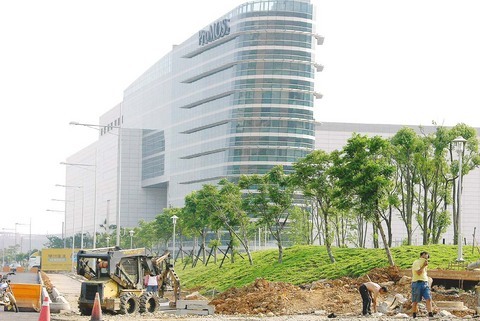Amid the rolling hills of Taichung County, a massive US$31 billion investment is fast changing a landscape of sugar cane and sweet potato farms into lines of slick towers, which will house the latest in cutting edge technology.
That technology will allow the Central Taiwan Science Park (中部科學園區) to deliver to the world's lounge rooms the latest in wide flat panel TVs and super computer screens, some big enough to match a three-seater couch in size.
But it is the speed of development and the rate of companies willing to sign on to the project, on the outskirts of Taichung City, that has impressed its backers and confounded critics.

PHOTO: AFP
Lai Ying-hsi (
"They felt why does Taiwan need another high-tech industrial park while the other ones in the south are only half booked by potential investors due to economic sluggishness," Lai said.
Since the study, 72 companies ready to invest NT$1.04 trillion (US$31.04 billion) have won approvals, among them industry leaders including AU Optronics Corp (友達光電), ProMOS Technologies Inc (茂德科技) and US-based Corning Inc.
Lai said that it was Taichung's stable electricity and steady water supply which eventually convinced the authorities to proceed. Taichung boasts one of a biggest thermal power plants in Asia, while chronic water shortages have dogged science and technology parks elsewhere in the country.
Yang Wen-ke (楊文科), deputy director-general of the Provisional Office of Central Taiwan Science Park (中科籌備處), said the rapid pace of its development -- in an industry which is consistently tied to tight construction deadlines to deliver next generation products -- was a big factor in winning over more firms.
The first companies began opening their doors within 10 months of the project's drafting.
"The pace of its development is the fastest ever in Taiwan's efforts to build high-tech industrial parks," Yang said. "It changed so fast, you would be amazed by the vast differences registered over every month."
It took AU Optronics just 15 months to complete construction of an NT$80 billion complex to produce 60,000 panels a month, including some for revolutionary 74x60 inch television sets.
"AU Optronics Chairman Lee Kun-yao (李焜耀) said `if AU Optronics had built the plant elsewhere, the construction may not have been as swift'," Lai said, adding that the project was completed 47 days ahead of schedule.
"That is important to a time-sensitive industry," Lai said.
US-based Corning followed suit, with a groundbreaking in September last year for a glass melting plant that will produce compacted glass substrate to be used in LCD screens.
Then came local memory chip maker ProMOS Technologies, which is designing cutting-edge 90-nanometer technology to produce microchips and 40,000 300mm wafers a month in two projects which cost NT$85 billion to build.
While optoelectronics will account for 34 percent of the park's ongoing investment projects, the balance will be filled by precision machinery, biotechnology, semiconductor, computer peripherals and telecommunication projects.
"The demand for land is much stronger than our previous estimates," Yang said.
Authorities plan to expand the size of the park to 1,200 hectares after 94 percent of the current 413 hectares of land was booked.
Yang said he was confident the new industrial park would eventually outperform the Hsinchu Science Industrial Park (新竹科學園區) in the north, which has been hailed as the nation's answer to Silicon Valley in the US.
The Hsinchu science park houses 384 high-tech companies focusing on semiconductors, telecommunications, and computer related industries. It churned out products worth US$32.41 billion last year.
But the LCD and microchip industry is renowned for its huge consumption of water and investors at Hsinchu have been annoyed by past occasional water shortages.
"The new industrial park is fast coming from behind," Yang said proudly of the Taichung project.
Lai touched a raw nerve in regards to competing parks elsewhere, when he asked rhetorically: "Have you ever heard of central Taiwan being gripped by a water shortage?"

CHIP RACE: Three years of overbroad export controls drove foreign competitors to pursue their own AI chips, and ‘cost US taxpayers billions of dollars,’ Nvidia said China has figured out the US strategy for allowing it to buy Nvidia Corp’s H200s and is rejecting the artificial intelligence (AI) chip in favor of domestically developed semiconductors, White House AI adviser David Sacks said, citing news reports. US President Donald Trump on Monday said that he would allow shipments of Nvidia’s H200 chips to China, part of an administration effort backed by Sacks to challenge Chinese tech champions such as Huawei Technologies Co (華為) by bringing US competition to their home market. On Friday, Sacks signaled that he was uncertain about whether that approach would work. “They’re rejecting our chips,” Sacks

NATIONAL SECURITY: Intel’s testing of ACM tools despite US government control ‘highlights egregious gaps in US technology protection policies,’ a former official said Chipmaker Intel Corp has tested chipmaking tools this year from a toolmaker with deep roots in China and two overseas units that were targeted by US sanctions, according to two sources with direct knowledge of the matter. Intel, which fended off calls for its CEO’s resignation from US President Donald Trump in August over his alleged ties to China, got the tools from ACM Research Inc, a Fremont, California-based producer of chipmaking equipment. Two of ACM’s units, based in Shanghai and South Korea, were among a number of firms barred last year from receiving US technology over claims they have

It is challenging to build infrastructure in much of Europe. Constrained budgets and polarized politics tend to undermine long-term projects, forcing officials to react to emergencies rather than plan for the future. Not in Austria. Today, the country is to officially open its Koralmbahn tunnel, the 5.9 billion euro (US$6.9 billion) centerpiece of a groundbreaking new railway that will eventually run from Poland’s Baltic coast to the Adriatic Sea, transforming travel within Austria and positioning the Alpine nation at the forefront of logistics in Europe. “It is Austria’s biggest socio-economic experiment in over a century,” said Eric Kirschner, an economist at Graz-based Joanneum

OPTION: Uber said it could provide higher pay for batch trips, if incentives for batching is not removed entirely, as the latter would force it to pass on the costs to consumers Uber Technologies Inc yesterday warned that proposed restrictions on batching orders and minimum wages could prompt a NT$20 delivery fee increase in Taiwan, as lower efficiency would drive up costs. Uber CEO Dara Khosrowshahi made the remarks yesterday during his visit to Taiwan. He is on a multileg trip to the region, which includes stops in South Korea and Japan. His visit coincided the release last month of the Ministry of Labor’s draft bill on the delivery sector, which aims to safeguard delivery workers’ rights and improve their welfare. The ministry set the minimum pay for local food delivery drivers at